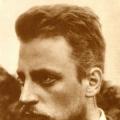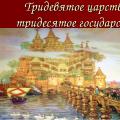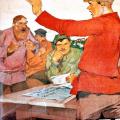Kirov railway map Kirov Railway
In the northern part of the Volga region federal district The Kirov region is located. In terms of the area occupied, which is 120 thousand square meters. km, this region is considered one of the most significant in the country. A map of the Kirov region from a satellite allows you to examine its borders in detail, settlements, rivers and transport routes.
The region's lands are heavily swamped. Huge swamps, the most significant of which in terms of area are located in the northern part of the region, occupy about 40% of all land in the region. More than 19 thousand rivers flow through the regions, the largest of which is the Vyatka. Also, looking at the map of the Kirov region with diagrams, you will find such waterways as:
- Pocket;
- Cap;
- Tansy;
- Moloma;
- Cobra.
The hydrography of the region is represented by a large number of lakes and ponds. In total, there are about 5 thousand closed reservoirs in the region.
The region's territory is limited by several constituent entities of the Russian Federation. If you move around the map of the Kirov region with its districts, you can see that its “neighbors” are:
- Mari El Republic;
- Kostroma region;
- Udmurtia;
- Komi;
- Vologda Region;
- Tatarstan;
- Nizhny Novgorod Region.
The region is home to approximately 1,370,000 people. The vast majority of people (76%) live in cities. The largest settlement and regional center is Kirov.
Districts of the Kirov region on the map
The region is divided into 39 districts. All areas on the map of the Kirov region can be examined in detail, sights can be found, and an idea of industrial zones and roads connecting cities and villages can be found. Of all the regions, Verkhnekamsk occupies the largest territory. It is located in the northeast of the region, so this area is always colder than others.
The smallest is the Vyatsko-Polyansky district, but it is inhabited by greatest number of people. It is divided into two parts by the Vyatka River. A map of the Kirov region with settlements makes it possible to see the city of Vyatskie Polyany on the right bank of the Vyatka, where industrial enterprises, universities, a museum and various attractions are located. The left bank part of the district is mainly involved in agriculture.
Part of the Trans-Siberian Railway passes through the regions, as well as the Kirov-Kotlas highway. On detailed map roads of the Kirov region, you can find the main routes, see how to get to the cities of the region, and also build a route for travel to neighboring regions. Using the online service, you can also consider the railway tracks that pass through all districts except Kumensky and Slobodsky.
Map of the Kirov region with cities and villages
If you look at the map of the Kirov region with villages and cities, you will notice that there are few large settlements in the region. Industrial and cultural centers are Kirovo-Chepetsk and Kirov.
But small settlements also have many attractions, which tourists from other regions often come to visit. If you come here for the first time, then use the map of the Kirov region with villages, which will help you find interesting places places you would like to visit:
- N. Pochinok - Church of St. Nicholas the Wonderworker;
- With. Veloretskoye - an ancient temple;
- Kotelnich - Nurgush Nature Reserve.
In villages and villages, ancient buildings have been preserved, which are recognized as architectural monuments. Those interested in the history of the region and art should visit Kirov. The city has such attractions as:
- arboretum;
- Museum of M. Saltykov-Shchedrin;
- Paleontological Museum.
The map of the Kirov region will show in detail how to drive or access any object. It is convenient to use on any travel, pilgrimage or business trip.
Economy and industry of the Kirov region
The main contribution to the economy of the Kirov region is made by industrial enterprises. Factories of various industries operate in the cities of the region. The region has developed industries such as:
- chemical;
- metallurgical;
- light;
- food
Use Yandex maps of the Kirov region to find plants and factories that produce products for the aviation industry, fertilizers, plastic products, car tires, plywood. Light industry enterprises are famous for their fur and leather products.
Peat is extracted from mineral resources here. And the main wealth of the region is coniferous forests, which occupy more than half of the entire territory of the region.
Agriculture is represented by crop production and livestock farming. Main crops grown in the region:
- rye;
- potato;
- forage crops.
Great importance is given to the development of tourism in the region. There are about 200 nature reserves and 3 resort areas. During the summer season, the lakes attract many vacationers, eco-tourists and fishermen.
The Kirov region is located in the central-eastern part of European Russia. A map of the Kirov region shows that the region borders the Nizhny Novgorod, Arkhangelsk, Kostroma and Vologda regions, the Republics of Komi, Mari El, Udmurtia and Tatarstan, as well as the Perm Territory. The area of the region is 120,374 square meters. km.
The Kirov region is extremely rich in forests, peat, furs and phosphorites. The main sectors of the region's economy are metalworking, mechanical engineering, metallurgy, pulp and paper and woodworking industries.
The region is divided into 39 municipal districts, 273 villages, 53 urban settlements and 6 urban districts. Largest cities Kirov region - Kirov (administrative center), Kirovo-Chepetsk, Slobodskoy, Kotelnich and Vyatskie Polyany.
Historical reference
In 1920, the territory of the modern Kirov region was part of the Vyatka province. In 1929, the territory became part of the Nizhny Novgorod region, and then Nizhny Novgorod region. In 1934, the Kirov region was formed, which in 1936 was transformed into the Kirov region.

Must Visit
On a detailed map of the Kirov region from a satellite you can see a number of cities in which the main attractions of the region are located: Kirov, Slobodskoy and Kotelnich.
It is recommended to visit the Church of Seraphim of Sarov, the Assumption Trifonov Monastery and the Alexander Garden in Kirov; Catherine's Cathedral, St. Nicholas Church, the bell tower of the Transfiguration Church and the Archangel Michael Gate Chapel in Slobodskoye; Velikoretsky castle in the village of Velikoretskoye; places associated with the artist Vasnetsov in the village of Ryabovo, as well as pareiasaurs - the remains of prehistoric lizards - in Kotelnich.
Fans of eco-tourism will be interested in the Bylina, Bushkovsky Forest and Pizhemsky nature reserves, the Nurgush nature reserve and national park“Atarskaya Luka”, lakes Lezhninskoye and Shaitan.
Note to tourists
Gulrypsh - a holiday destination for celebrities
There is an urban-type settlement Gulrypsh on the Black Sea coast of Abkhazia, the appearance of which is closely connected with the name of the Russian philanthropist Nikolai Nikolaevich Smetsky. In 1989, due to his wife’s illness, they needed a change of climate. The matter was decided by chance., Petrozavodsk
The building in Petrozavodsk in which the Directorate was located Kirovskaya railway.
In 1959, it was included in the structure of the October Railway with management in the city of Leningrad as the Order of the Red Banner of Labor Murmansk branch of the Order of Lenin of October railway .
Control
Control Murmansk railway founded in 1917. It was located in the city of Petrozavodsk. In January 1918, a board consisting of representatives from the Olonets, Murmansk and Petrograd Soviets and three delegates from the Main Road Committee was formed to manage the road. In March 1918, the executive committee of the Council of Railway Deputies was formed. In 1919, the management of the road was transferred to the city of Petrograd. In 1922, the Board was organized Murmansk railway. On May 1, 1930, the Management Board was liquidated and the Directorate was organized Murmansk railway.
Kirov Railway had management.
On May 22, 1940, by order of the People's Commissariat of Railways, from July 1, 1940, the location of the administration of the Kirov Railway was determined to be Petrozavodsk.
Control Kirov Railway consisted of:
- secretariat
- planning department
- accounting department
- finance department
- forest department
- automobile department
- military department
- HR department
- department of educational institutions
- Work Supply Department
Control Kirov Railway was in charge of services:
- buildings and structures
- movement
- passenger
- signaling and communications
- electrification
- fuel economy
- carriage
- medical and sanitary
- logistics
- traffic inspector.
Railway had a number of printed organs published in Petrozavodsk - the newspapers “Murmansky Put” (“The Way”) (1917), “Red North” (organ of the Executive Committee of the Council of Deputies of the Murmansk Railway) (1918), “Polar Highway” (1933-1936 ), “Kirovskaya Magistral” (1936-1959), the political departments of the branches in Petrozavodsk also had their own newspapers - “Transportnik” (the organ of workers and employees of the 2nd district of the Murmansk Railway) (1930-1935), “Semafor” (the organ party committee and MK of the traffic service of the Petrozavodsk station (1934), “Puteets” (organ of the party and trade union organization of the 3rd distance) (1934), Kandalaksha - “Polar whistle” (organ of the political department and district trade union body of the 4th department of the Murmansk railway) (1931-1935) , "Sleeper" (organization of the party organization and MK of the 8th track distance) (1934), "Udarnaya electromagistral" (organ of the party committee and educational committee of the 1st section of electrification of Kandalaksha of the Kirov railway (1935) and Kemi - "Kemsky transport" (organ of collectives All-Union Communist Party of Bolsheviks and local committees of the Kem station (1934), the road took part in the publication of the socio-economic magazine “Bulletin of the Murmansk Railway” (“Bulletin of Murman”, “Bulletin of the Karelo-Murmansk Territory”, “Karelo-Murmansk Territory”) ( 1923-1935). In 1922-1926. in Petrograd (Leningrad) the “Bulletin of the Murmansk Railway” (“Bulletin of the Management of the Murmansk Railway”) was published.
Story
After Emperor Nicholas II approved on January 1, 1915 the construction of railways from Petrozavodsk to Sorotskaya Bay and further to the Murmansk coast at the expense of the treasury, a department was created for the construction of the Petrozavodsk - Sorotskaya Bay and Murmansk railway lines under the general leadership of engineer V.V. Goryachkovsky. On the Petrozavodsk-Soroka road section, construction work was supervised by engineer V.L. Lebedev, on the Soroka-Murman section - by engineer P.E. Solovyov.
The official Act on acceptance for temporary operation of the Murmansk Railway was signed on November 15, 1916. In 1917, the construction department was liquidated, and the Murmansk Railway Department was formed, headed by the head of the road.
From April 1, 1917 to Murmansk railway annexed, purchased by the state, private Olonets railway(line Zvanka station - Petrozavodsk station).
Temporary goods movement was open from January 1, 1917, from April 1, 1917 Murmansk railway included in direct communication with Russian railways.
On September 15, 1917, regular passenger traffic began; passenger train No. 3/4 passed along the entire section of the road from Zvanka to Murmansk.
In 1917, the number of permanent workers and employees of the Murmansk Railway was about 16.5 thousand people.
In 1919, part of the road (in the Kemsky and Aleksandrovsky districts of the Arkhangelsk province) was controlled by the Provisional Government of the Northern Region and was subordinate to the head of the regional transport routes in Arkhangelsk.
January 20th 1919 a to Murmansk railway the Tikhvin - Rybatskoye section was added Northern Railway.
On December 19, 1936, the electrified section Kandalaksha - Apatity was put into operation.
In February-April 1940, the Petrozavodsk - Suoyarvi line was built.
The most violent and systematic attacks on targets Kirov Railway were carried out in December and in the first half of the year. Enemy aircraft were especially active on the 164 km section of the road from Kandalaksha station to Loukhi station. In this direction the enemy had an airfield, from which to Kirov Railway it was only 75 km, that is, 10 minutes of flight.
Above the Kirov Railway, I. G. Inozemtsev, Winged Defenders of the North.
On July 13, 1959, by Decree of the Council of Ministers of the USSR No. 748 “On Strengthening Railways” and by Order of the Ministry of Railways of the USSR No. 42 of July 14, 1959 Kirov Railway And Oktyabrskaya Railway were merged into the Oktyabrskaya Railway with management in Leningrad.
List of some road leaders (years)
Heads of the Murmansk Railway Construction Department
- Vladimir Vasilievich Goryachkovsky (1914-1917)
Head of work on the construction of the Murmansk railway
Heads of temporary operation of the Murmansk railway
- Anatoly Vladimirovich Skopichenko (1917)
Commissioners, chief road commissioners and chairmen of the executive committee of the commissariat for the management of the Murmansk Railway
Chairman of the Board of the Murmansk Railway and the Murmansk Plant
Heads of the Murmansk (Kirov) Railway
see also
Notes
- The management of the Murmansk Railway moves to Petrograd. The representative office of the road remains in Petrozavodsk // News of the executive committee of the Olonets Council of Peasants, Workers and Red Army Deputies. 1918. December 6
- Nikolsky I.M. Nature, population, economy, history and culture of Karelia // Bibliographic index. Issue 1. Petrozavodsk: Petrozavodsk Publishing House state university, 2008. P.36-37

 Erich Maria Rilke. Brief biography of R.M. Rilke. Paris. "New Poems"
Erich Maria Rilke. Brief biography of R.M. Rilke. Paris. "New Poems" Artania - the distant kingdom, the thirtieth state
Artania - the distant kingdom, the thirtieth state The beginning of the policy of dispossession
The beginning of the policy of dispossession